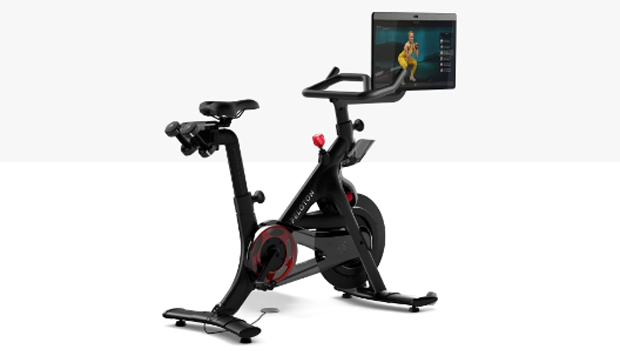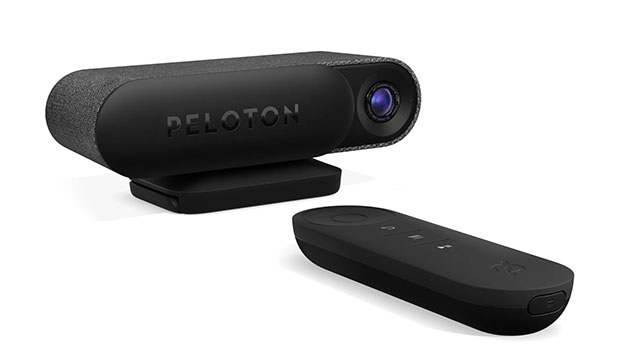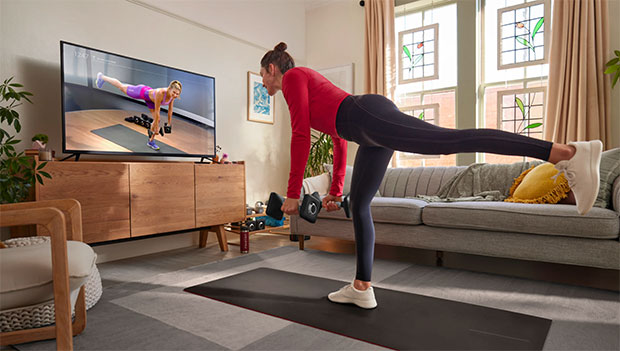
Smart workout equipment makes exercising at home more accessible, convenient, and, for many people, a lot more enjoyable. That's why companies like Tonal and Peloton are at the forefront of making connected fitness machines like bikes, treadmills, and AI-powered smart gyms available to the masses. But with so many options, finding the right interactive home-gym equipment to fit your needs and budget takes some serious research skills, in-person testing (if possible), and time. Fortunately, we've done a lot of the legwork for you.
One way to get started is to make a side-by-side comparison of Tonal versus Peloton. Both companies offer products that can provide you with an excellent workout, but beyond that, it's important to consider the differences before making a purchase. For example, if a smart gym is on your list, the Tonal digital workout system is worth considering. This high-tech home gym allows users to perform over 200 exercises with up to 200 pounds of resistance—no dumbbells, barbells, or bulky equipment required. But if a serious cardio workout with a side of strength training, yoga, bootcamp, and Pilates is more your style, the Peloton Bike or Peloton Tread might fit your needs better. Both home cardio machines come with an HD touchscreen to stream live and on-demand classes.
You'll also want to factor in cost. Smart home exercise equipment is pricey, plus they require a monthly subscription to access premium content—another thing to remember when tallying up the total cost. Although Tonal and Peloton require an initial investment and a monthly fee, it could pay off over time if you use the equipment consistently.
Here, the ACTIVE Reviews Team compares Tonal and Peloton to see which company comes out on top for cardio, strength, budget, and overall home exercise equipment.
Why Trust Us?
ACTIVE.com's editorial team relies on the knowledge and experience of fitness and wellness experts including competitive athletes, coaches, physical therapists, nutritionists, and certified trainers. This helps us ensure the products we feature are of the highest standard. Collectively, the team has spent countless hours researching equipment, gear, and recovery tools in order to create the most accurate, authentic content for our readers. Customer satisfaction is also a key part of our review process, which is why we only feature products that are highly rated. More importantly, each member of our team is a fitness enthusiast. Fitness may be our job, but it is also our passion. Therefore, we strive to bring you products that we trust and would personally use.
By clicking on the product links in this article, we may receive a commission fee at no cost to you, the reader. Read the full affiliate disclosure here.
A Quick Look at Tonal
With a focus on creating a single machine that could replace resistance equipment in a weight room, Aly Orady released his brainchild, Tonal, in 2018. Tonal is a connected digital weight system that delivers a strength-training experience using magnets and electricity. This smart gym allows you to perform full-body workouts in the comfort of your own home.
Tonal Home Gym

The Tonal smart home gym replaces traditional weight room equipment like barbells, cable machines, and dumbbells with a high-tech machine that uses two adjustable arms to deliver up to 200 pounds of resistance for over 200 upper- and lower-body exercises. The extra-large touchscreen is fixed to the wall for easy viewing of interactive programming like strength, yoga, pre- and post-natal, HIIT, and stretching, among thousands of other workouts and classes. A weight bench and other smart attachments are available as add-ons.
Tonal uses AI to analyze every part of your workout, starting with a full-body strength assessment that allows the technology to automatically set the optimal weight to match your strength. And, as you get stronger, the resistance increases. We also like the spotter feature that detects signs of struggle or fatigue during a workout and automatically decreases weight during a lift.
SPECS
- Footprint: 7' unobstructed wall space and ceiling height of 7' x 10"
- Space requirements: Requires 7' x 7' of floor space for bench
- Maximum resistance: 200 lbs. (100 lbs. in each hand)
- Display: 24" touchscreen
- Tonal app/class: Access to unlimited accounts, extensive library of workouts and programs, and intelligence tools
- Membership: $49/month, includes unlimited accounts for everyone in your household
- Key features: Intelligence tools like strength assessment, video demos, spotter mode, and intuitive weight adjustments; adaptive weight; adjustable arms for upper- and lower-body movements
- Warranty: 3-year limited warranty
PROS
- 30-day home trial
- Requires minimal floor space while working out
- Bench is easy to move and store when not in use
- Machine is quiet
- Offers exercises and workouts for a versatile full-body routine
- Auto-adjusting resistance
- Smart handles make it easy to adjust resistance
- Form feedback lets you know if you're doing the moves correctly
CONS
- Expensive upfront cost
- Accessories cost extra
- Need a good-sized wall and close proximity to an outlet
- Installation by a Tonal professional is required
- Walls must meet strict requirements for installation
- Arms require manual adjustment for each lower- and upper-body exercise
- May not be enough resistance for experienced or strength-focused lifters
A Quick Look at Peloton
In 2012, John Foley introduced the Peloton Bike to the at-home fitness scene, and shortly after, Peloton began manufacturing this trademark product. Several years later, in 2020, the Peloton Bike+ was released, giving indoor cycling enthusiasts a few upgrades to this popular indoor bike.
After creating a massive fan base with the Bike and Bike+, Peloton decided to test the waters with runners and released the Tread in 2018. It was updated shortly after and a new version was released in 2021. Peloton pivoted directions from cardio machines and in April of 2022 released the Guide. This latest piece of connected exercise equipment is a small camera that turns your TV into a guided workout experience. Here, we take a look at the Bike, Tread, Guide, and Peloton's wildly popular workout app.
Peloton Bike

The original Bike that solidified Peloton's reputation as a force in the home exercise equipment industry is still a top seller more than nine years after it was released. Why? For starters, the company dropped the price, making it more affordable. They also continue to produce high-quality programming led by top-notch instructors.
Classes include live and on-demand options for cycling, and off-bike classes for strength, stretching, running, yoga, and Pilates, among others. The class length is another plus, with workouts ranging from 5 to 90 minutes.
The bike itself is quiet and easy to operate. It doesn't take up a ton of room, plus, you can try it for 30 days to make sure it's the right fit for your home. The Peloton Bike comes with 100 levels of resistance, making it an excellent choice for most fitness levels.
SPECS
- Dimensions: 59" L x 53" H x 23" W, 4' x 2' footprint
- Weight: 135 lbs.
- Frame: Welded steel, ED and powder coated
- Max user weight: 297 lbs.
- Pedal style: Delta-compatible aluminum pedals
- Resistance: 100 levels of manually controlled magnetic resistance
- Display: 21.5" 10-point touchscreen
- Console connectivity: Bluetooth 4.0 connectivity, WiFi, ANT+ wireless
- Peloton app/classes: Live and on-demand classes, $39/month ($44/month beginning June 1, 2022)
- Key features: Scenic rides curated to music, individual profiles for household access, thousands of live and on-demand classes
- Warranty: 12-month limited warranty on parts and labor, 5-year coverage on frame
The Bike+ is a boosted version of the original Bike. This pricier model is built with the same solid steel and ergonomic design but comes with a few added features:
- A slightly larger touchscreen that rotates 360 degrees for off-bike workouts
- Improved sound quality
- Auto-resistance changes your resistance to match the instructors' cues
- Apple GymKit integration
- 4GB RAM compared to 2 in the original Bike
- USB-C charging port for devices
- Bluetooth 5.0 connectivity compared to 4.0 on the original Bike
PROS
- Extensive library of live and on-demand classes for cycling, strength training, Pilates, yoga, running, bootcamp, boxing, and cardio
- Sturdy frame and solid construction
- Large touchscreen
- 30-day home trial allows you to try the bike free of charge
- Whisper-quiet pedaling and comfortable ride with ergonomic handlebars
CONS
- High upfront cost
- Monthly membership more expensive than competitors
- Maximum user weight is 297 lbs.
- $250 shipping and set-up fee
Peloton Tread

The Peloton Tread is a high-quality, well-constructed treadmill that gives users an all-inclusive virtual training experience in the comfort of their own home. It comes with easy-to-use speed and incline knobs for mid-workout adjustments. The Tread is made for people ranging in height from 4-foot-11 to 6-foot-4 and weighing 105 to 300 pounds—something to keep in mind if your body size is outside of this range. Also, the slightly smaller running surface might not work for people with longer strides. The Peloton Tread can support running speeds up to 12.5 miles per hour and inclines of 0-12.5 percent, making this an excellent machine for all fitness levels. Like the Bike, you can stream live and on-demand classes on the 23.8-inch HD touchscreen with the All Access Membership. Peloton recently updated the Tread to include a password protected Tread lock and safety key to help prevent potential injury.
SPECS
- Dimensions: 68"L x 33"W x 62"H
- Weight: 290 lbs.
- Frame: Carbon steel
- Max user weight: 300 lbs.
- Running area: 59"L x 20"W
- Motor: 3HP DC
- Incline: 0%-12.5%
- Speed: 0-12.5mph
- Display: 23.8" HD touchscreen
- Console connectivity: Bluetooth 5.0 connectivity, WiFi, ANT+ wireless
- Peloton app/classes: Live and on-demand classes with paid subscription, $39/month ($44/month beginning June 1, 2022)
- Programming: Access to thousands of live and on-demand treadmill classes, scenic runs with curated music, total-body strength classes, Pilates and yoga classes, and more
- Warranty: HD touchscreen 12-month full warranty, 12-month components limited warranty, 5-year frame, 3-year drive motor and walking belt
PROS
- Extensive library of live and on-demand classes for cycling, strength training, Pilates, yoga, running, bootcamp, boxing, and cardio
- Tread Lock protects from unauthorized access
- Extra-large touchscreen
- Smooth running experience and excellent shock-absorbing belt
- Easy-to-use knobs make for quick speed and incline adjustments
- 30-day risk-free home trial
CONS
- Very high upfront cost
- Monthly membership more expensive than competitors
- Requires a decent amount of space
- Does not fold up for storage
- Slightly smaller running area than similar treadmills
Peloton Guide

Peloton recently introduced its newest connected device, the Guide, which focuses on strength workouts more than cardio. The Guide is a compact camera that connects to your TV. It streams live and on-demand resistance and strength-based classes that target upper- and lower-body muscles.
When the Guide is in self mode, you will see yourself on TV doing the movement side-by-side with Peloton strength instructors, eliminating concerns about performing an exercise incorrectly. The body activity feature shows you which muscles you hit the most during any workout. You then get personalized class recommendations for rounding out a total-body routine. While the Guide is a smart device for working out safely at home, it is pricey and requires a monthly membership.
SPECS
- Dimensions: 6.5"L x 2.5"W x 1.7"H, 6.5"L x 2.5"W x 2.6"H (dimensions with stand)
- Weight: 18 oz.
- Display: Camera plugs into TV
- Recommended floor space: 4.5' x 6' of space to perform movements
- Connectivity: Bluetooth 5.0, WiFi
- Monthly membership: $24/month introductory Guide pricing through 2022 upon device activation, $44/month after that
PROS
- 30-day home trial
- Camera requires minimal space
- See yourself on the screen next to the trainer
- Extensive library of live and on-demand classes
- Offers personalized class recommendations
- Introductory price for All Access Membership
CONS
- Requires a TV for use
- Expensive piece of equipment for what you get
- Does not give form feedback, count reps, or give weight suggestions
- Workout mat and dumbbells cost extra
Peloton App

The Peloton App is a more affordable and accessible version of the All Access Membership. It does not require a Peloton machine to use, and you can stream thousands of live and on-demand classes taught by expert-level instructors on a variety of compatible devices. Classes include strength, boxing, running, cycling, yoga, bootcamp, Barre, Pilates, meditation, walking, and stretching. Plus, it is easy to use and filter by time, type, instructor, and music. The app has guided runs that keep track of pace, elevation, and other metrics with a GPS-supported iOS device. It also tracks heart rate while you're wearing an Apple Watch. And the best part? The Peloton App is currently only $12.99 per month.
SPECS
- Compatibility: iOS, Android, Roku; mobile device, tablet, computer, TV
- Language(s) : English, German, some classes in Spanish
- Live classes: Yoga, cardio, cycling, Pilates, running, boxing, stretching, meditations, walking, bootcamp, barre, and strength
- On-demand classes: Thousands of pre-recorded classes
PROS
- Affordable monthly price
- Does not require a Peloton exercise machine
- 30-day free trial
- Ability to filter classes by type, instructor, time, music, live, on-demand, and difficulty
- Classes range in length from 5-60 min.
CONS
- Some of the cycling and treadmill classes are specific to Peloton equipment
- Strength training and floor classes may require additional equipment
Tonal vs. Peloton: Which is Best?
The home-gym market is saturated with all kinds of exercise equipment ranging from high-priced indoor cycles and treadmills to smart gyms that double as resistance machines. Here, we take a closer look at how Tonal and Peloton compare in several different categories.
Tonal vs. Peloton: Which is Best for Losing Weight?
Both Tonal and Peloton are designed to aid in weight loss. Peloton offers more ways to lose weight by combining their cardio equipment with off-machine calorie-burning workouts like walking, resistance training, and bootcamp. But Tonal features 200 pounds of resistance and strength-training classes that help build lean muscle mass and burn calories during and after a workout.
Tonal vs. Peloton: Which is Best for Building Muscle?
Tonal is the better choice for building muscle because it comes with 200 pounds of resistance and programming focused on full-body strength training. Tonal instructors demonstrate over 200 strength and muscle-building moves for upper and lower body.
Tonal vs. Peloton: Which is Best for Cardio Training?
The Peloton Bike and Tread are best for cardio training. That's because the machines and programming are designed to boost cardiovascular function and endurance levels. If aerobic exercise is your primary goal, consider one of these machines.
Tonal vs. Peloton: Which is Best for App and Subscription?
Peloton offers more programming at a lower monthly cost than Tonal, making it the better choice for subscription and app. The Peloton All Access Membership allows you to stream live and on-demand classes right to the connected touchscreen. They also offer a lower-priced Peloton App that allows you to stream classes to a mobile device, tablet, computer, or TV without using a Peloton machine.
Tonal vs. Peloton: Which is Best for Classes?
Both brands have excellent classes, although most reviewers think Peloton is better for classes overall. They have programming for strength, boxing, running, cycling, meditation, walking, yoga, Pilates, barre, and bootcamp. Peloton also has scenic rides curated to different music genres. Each week, they add new live classes and keep an on-demand library of thousands of older classes. You can search for classes based on instructor, time, music, difficulty, and type of class.
Tonal offers classes for strength training, HIIT, dance cardio, yoga, mobility, kickboxing, sport performance, Barre, meditation, recovery, Pilates, pre and post-natal, family fun, and bootcamp. You can work out alongside other members with the live classes and create groups with other members to take classes at the same time.
Final Thoughts on Tonal vs. Peloton
Tonal and Peloton both provide quality home exercise equipment supported by smart technology and excellent classes and workouts. Choosing between Tonal and Peloton comes down to budget, fitness goals, and your specific needs. So, the first thing to consider when deciding between Tonal and Peloton are your fitness goals. If cardio tops the list, then the Peloton Bike or Tread are worth considering. But if strength-training workouts are the priority, Tonal is the clear winner.
Both Tonal and Peloton are pricey. If money is a deciding factor and resistance training is the goal, the Peloton Guide is a good place to start. When comparing cardio options, the Peloton Bike is more affordable than the Tread, making it the better choice for a budget-friendly option. You also need to think about space and location. If mounting equipment on a wall is not an option, the Peloton Guide is your go-to for strength training. But if having access to a comprehensive library of exercises and workouts is key and you can afford it, we think Tonal is an excellent addition to a home gym lineup.
FAQs About Tonal vs. Peloton
Is Peloton better than Tonal?
Whether or not Peloton is better than Tonal depends on your fitness goals. If you're looking for cardio equipment, then yes, Peloton is likely the better choice. But if you're more interested in resistance training, then Tonal is the smarter option. Both companies provide a quality product with a fee-based monthly subscription to access classes and other programming. However, we feel the Peloton All Access Membership offers more variety and class choices than the Tonal app. Plus, the Peloton App does not require Peloton equipment.
Is Tonal worth it?
Tonal comes with a hefty price tag. It also has a higher monthly membership fee than other companies, including Peloton. That said, the AI-powered technology and diverse class options, instructors, and customizable workouts are top-notch, making this smart workout mirror a good choice for some fitness enthusiasts. However, the high cost, 200-pound maximum resistance, and wall requirements make it less ideal for many other people.
Is Peloton worth it?
Like Tonal, the Peloton Bike, Tread, and Guide come with high upfront costs plus a monthly membership fee. However, they also provide an immersive fitness experience, community support and motivation, and quality programming. So, if having access to excellent cardio machines, industry-leading instructors, and a wide range of class options are high priorities for you, Peloton may be worth it.
Does Tonal have bike workouts?
No, Tonal does not have bike workouts. Currently, Tonal offers classes in the following categories: strength training, HIIT, dance cardio, yoga, mobility, kickboxing, sport performance, barre, meditation, recovery, Pilates, pre- and post-natal, family fun, and bootcamp.
Can I use a Tonal without a subscription?
You are locked into a 12-month subscription after purchasing Tonal. After the initial commitment period, you can pause or cancel the membership, but you will lose access to the workout library and personalization features. However, you can continue to use Tonal without a subscription. If you cancel, you still have access to the weight dial and ability to increase and decrease the weight, safety features, and WiFi settings for receiving updates.
Can I use a Peloton without a subscription?
Yes, you can use a Peloton without a subscription. However, you won't be able to stream live content or on-demand classes through the touchscreen. You also lose access to the metrics in your user profile and leaderboard. Using Peloton without a membership gives you access to the Just Ride feature and a select number of pre-recorded classes. You will also continue to see cadence, resistance, speed, calories, time, and other stats on the screen, but the metrics will not be saved.


